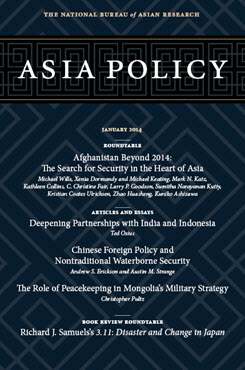The New Great Game
Pakistan's Approach to Afghanistan after 2014
This is one of nine essays in the roundtable “Afghanistan Beyond 2014: The Search for Security in the Heart of Asia.”
NOTE: The views expressed in this essay do not necessarily reflect the official policy or position of the Department of the Army, Department of Defense, or U.S. government.
A modern day Great Game is playing out in Inner Asia once again. Like the Great Game of the nineteenth century, it centers on Afghanistan, a land that falls outside every state’s sphere of influence and has always been intensely hostile to foreigners, making it a perfect playing field. China, India, Russia, and the United States are the major powers embroiled in competition in and around Afghanistan, but Pakistan is also very much in the game. As the most significant front-line state, as well as the country of first asylum to the largest number of Afghan refugees (and largest refugee population in the world from 1982 to 1997), Pakistan correctly saw itself as having invested much in Afghanistan during the Soviet occupation in the 1980s. This investment cost Islamabad a great deal, however, even as it provided a great opportunity. Afghan mujahideen operated from Pakistani soil to attack Afghanistan, causing retaliatory attacks by the Soviet and Afghan governments that accompanied all the ills that millions of refugees can inflict on a poor state. At the same time, Pakistan’s Directorate for Inter-Services Intelligence (ISI) used the Afghan war of the 1980s to refine its strategy of leveraging asymmetric actors to influence events in hostile or less-governed spaces in the country’s immediate neighborhood. This goes to the heart of the security dilemma facing Pakistan today, which also helps explain its problem with India and how Afghanistan after 2014 fits into that relationship.
The Great Game construct offers much to our understanding of post-2014 Afghanistan and the factors that will likely drive the competition there. This essay articulates Pakistan’s primary national interests in Afghanistan and how those interests can be expected to play out in the context of the interests of the other major actors that are also engaged there. It will conclude with some predictions about Pakistan’s post-2014 approach to Afghanistan.
Pakistan and Afghanistan: Historical Context
Even before the partition of 1947, Pakistan’s security consciousness has been dominated by the perceived threat posed by its larger neighbor India, with which it has fought four wars and numerous smaller conflicts. India’s sheer size has helped it prevail in all these military exchanges, prompting Pakistan to invest more and more in its military over time. Today, Pakistan has a large and very professional military with a poor track record against India’s military, a large nuclear arsenal with robust delivery systems (postured against India’s Cold Start conventional strategic doctrine), and an active use of asymmetric actors (guerrillas, insurgents, irregulars, and terrorists), especially in the contested area of Kashmir. This “strategic triad” both reflects and reinforces the fixation of the Pakistani military on India, motivates Pakistan’s spending and strategic doctrines, and causes it to focus increasingly on building, funding, training, and running asymmetric actors outside Pakistan.
In the 1990s, after the Soviet Union collapsed and the United States extricated itself from Afghanistan, only Pakistan remained deeply engaged there. Russia, the United States, China, and India all had other priorities: modern Russia was a weakened successor to the Soviet Union, the United States was focused on the Persian Gulf and Eastern Europe, China was reeling from the Tiananmen Square uprising, and India was set adrift from its treaty arrangement with the Soviet Union in the wake of the latter’s collapse. The United States left Afghanistan largely in the hands of Pakistan and Saudi Arabia, with a decade of increasingly virulent Islamism and destructive civil war as the result. In the latter half of the 1990s, Iran also became engaged in supporting its clients in western, central, and northern Afghanistan, deepening the civil war into ethnic-sectarian cleansing.
The Afghan war that erupted after September 11, 2001, changed the regional equation. Today, the United States plays the dominant role, but a rising China, emerging India, re-emerging Russia, troubled Iran, and other regional players all are actively involved in Afghanistan, as are multilateral and nongovernmental organizations. Naturally, national interests vary and in some cases are divergent. Pakistan views each country’s involvement in Afghanistan through the lens of its own interests.
Pakistan’s National Interests in Afghanistan
Pakistan has four major national interests in Afghanistan. First, Pakistan is home to over half of the world’s 50 million Pashtuns, who…
About Asia Policy
Asia Policy is a peer-reviewed scholarly journal presenting policy-relevant academic research on the Asia-Pacific that draws clear and concise conclusions useful to today’s policymakers. Asia Policy is published quarterly in January, April, July, and October and accepts submissions on a rolling basis. Learn more


